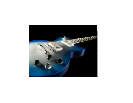
21
Avoid sharp blows to any part of your instrument. Be particularly alert to possible blows to the
back of the headstock, machine heads (tuners), and in the neck heel area. Many headstock
b r eaks are the result of a guitar being knocked over or dropped while it’s still in the case, so
do not stand the case on its end.
Should major adjustments become necessary, contact your local authorized Gibson dealer or
s e r vice center.
S t r i n g s .
F r esh strings are a vital part of that “new instrument” sound. When strings begin to go
dead, a guitar loses its edge, and as the strings undergo further wear and tear they go “dead.”
Your Gibson will sound its best with new strings.
How often should you change strings? That depends on how much you play your guitar, how
h a r d you play, and also on your individual body chemistry. Some professional musicians change
strings before every show in order to maintain the brightest edge on their sound. More casual
players may only need to change strings every month or two. For some players, even light per-
spiration shortens the life of their strings. The sound of the strings is the only sure way to judge
whether or not they need to be changed. And if one string needs to be changed, the others
c a n ’ t be far behind. To maintain tonal balance, change the whole set.


















